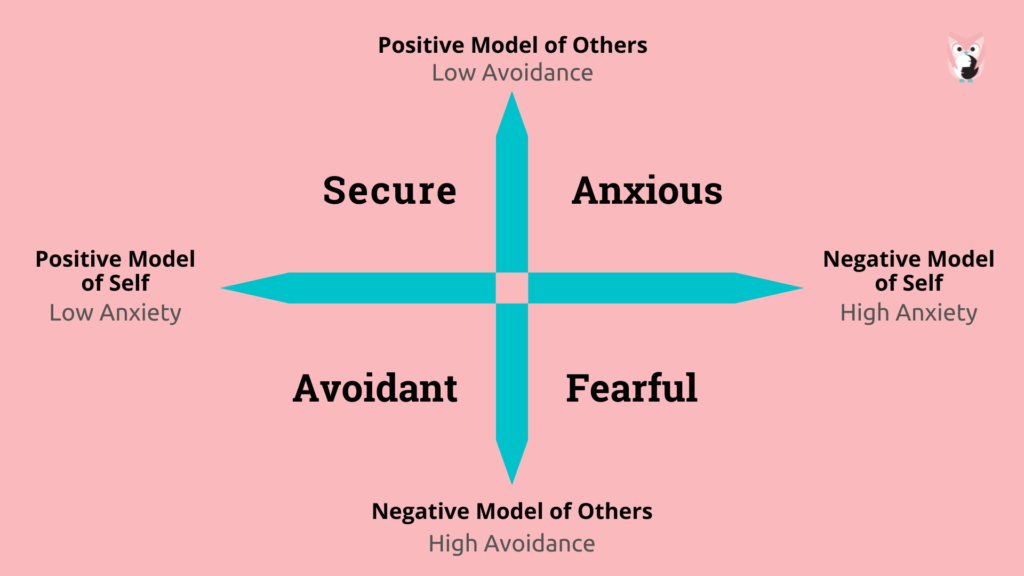Have you ever wondered how your child’s attachment to you would impact them in their adult lives? Attachment is a crucial component of the relationship between a kid and a parent, serving to make a child feel safe, secure, and protected. Understanding these early attachment patterns can play a significant role in your child’s Personality Development and future Confidence.
What Are Attachment Styles?
The pattern of conduct a kid adopts to uphold their relationship to their caregiver is known as an attachment style. John Bowlby, a child psychiatrist, is credited with developing attachment theory. The theory is based on Bowlby’s work about how kids cope with loss, suffering, and being apart from their caregiver.
Four types of attachment may be made from these newborn attachment patterns that emerged in early infancy in response to the actions of their caregivers.

Style 1: Secure Attachment Style
- Children that have a strong attachment are often content and dependable.
- They feel comfortable enough to travel and push the boundaries of their independence. Typical personality of these kids would show higher level of maturity, increased empathy, and less disruptive and angry behavior
- Securely attached kids show low levels of worry and anxiety with less avoidance.
Style 2: Anxious Attachment Style
- When babies receive uneven attention from their parents, anxious attachment forms. For e.g. kids would attach to their careers, show sadness when their caregiver leaves, and are wary and apprehensive around strangers.
- They start to question if their caretakers will be there for them when they need them. High levels of anxiety connected to attachment are present in anxious kids, which may affect their Body Language by making them appear tense or restless.
- An anxious adult reports high anxiety and low avoidance.
Style 3: Avoidant Attachment Style
- When an infant’s connection-seeking activities are rejected by the attachment figure, avoidant attachment develops.
- To protect themselves, they are avoidant and keep a safe emotional distance. As a coping mechanism, they deactivate and isolate themselves
- Low anxiety yet significant avoidance are characteristics of the avoidant style. A child of with this style might be afraid of physical touch, such as hugs and cuddles, and show early signs of insecurity since they prefer to play and engage with items rather than people.
Style 4: Fearful Attachment Style
- When the parent is also a source of harm or anxiety, fearful attachment develops.
- This attachment pattern usually develops as a result of mistreatment.
- A fearful-avoidant attachment style individual has significant levels of anxiety and avoidance for e.g. the child might act erratically and with hostility and they also might appear depressed, introverted, and unresponsive. This can deeply affect their Personality Development, making them more withdrawn and less expressive.
Why is it crucial to understand your child’s attachment style?
- The attachment style of a youngster might offer clues about how they will interact with their environment both now and in the future.
- You can learn about the kinds of interactions they may have had as children or even as adults by reading this.
- It can inform you about the kinds of difficulties your kid can experience as they develop.
Strengthen Parent – Child bond with Emotional Intelligence
How to nurture mentally healthy kids?
1. Enhance your child’s capacity for creativity
Free time promotes introspection and creativity. Children will create new ideas and methods of thinking during these times, solve issues, fantasize, envision, reflect on the past, and come up with solutions for the future, which are all crucial for their overall Personality Development.
2. Allow them to experience failure and mistakes
It’s crucial to not overprotect your child and to let them experience failure. This builds Confidence by teaching them resilience and the ability to learn from their mistakes.
3. Keep a watchful eye on your child’s conduct, both verbal and nonverbal
You can tell when things might not be quite right and when your child needs to talk about anything by observing their verbal and nonverbal behavior. Effective communication is the key, and understanding their Body Language can offer insights into their emotional state.
4. Encourage your child’s self-esteem and confidence
Increase your child’s self-confidence and self-esteem by giving them compliments and encouraging words like “Well done,” “You’re outstanding,” and “That’s excellent.” Positive reinforcement plays a vital role in their Personality Development.
5. Encourage your kid to form friendships
A child’s ability to develop friendships and social skills should be promoted.
Know about our Emotional Intelligence Course for Kids
Conclusion
Despite the fact that every kid has a particular attachment style, it’s crucial to understand that as a child progresses through developmental stages, he or she may exhibit behaviours typical of various attachment styles. It’s also critical to understand that a child’s attachment style may alter and improve as long as their parent regularly fosters feelings of security, love, and encouragement in them. An professional child development therapist should be consulted if you are worried about your kid’s attachment type.






Leave A Comment